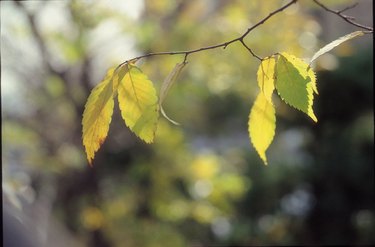
The Chinese pistache (pistacia chinensis) is an ornamental tree that thrives in zones 6 through 9. It will reach as tall as 35 feet in height with an equal spread and requires full sun exposure in order to do well. Though generally hardy, these trees may fall victim to a few pests and diseases. Yellowing leaves are a common early symptom, and should be addressed as soon as possible to prevent long term damage.
Poor Nutrition
Video of the Day
Poor soil conditions may lead to nutrient shortages, which may cause health problems, a increased pest and disease activity, and leaf yellowing. Nitrogen and iron are among the most important nutrients to plant health, and are both essential parts of chlorophyll production. This material gives leaves their green color, and without it leaves will turn yellow. Iron chlorosis, frequently a problem with over watering or improper pH, presents with leaves that yellow along the edges and move inward. Nitrogen shortages present with a more even discoloration. Adding an iron chelate and some well decomposed compost to the soil will help correct these conditions.
Video of the Day
Stress
Stress in plants may be caused by several environmental factors, pests or disease. Often, an early sign of stress in the Chinese pistache is leaf yellowing, which may progress to more discoloration, premature drop and possibly death of the plant if left untreated. Once established, these plants are quite drought tolerant, and will be able to adapt to numerous soil conditions. When first planted, however, sufficient water and a soil that is nutrient-rich and well draining is essential. In established plants, extended periods of drought, heat and sun may cause leaf yellowing, as might transplantation, improper pH and poor soil drainage. Growers should pay close attention to their pistache, particularly during the hot months of summer, and correct problems as soon as possible.
Watering and Soil
Over or under watering is most often a problem for young pistache trees, though established plants may suffer with prolonged drought. The pistache requires less water than many other tree species, and will adapt to most soil types. It is essential, though, that heavy clay soils provide at least moderate drainage, as standing water may lead to problems, while sandy soils may drain too quickly. For best results, and to prevent leaf yellowing, growers should allow the soil to dry completely before watering again. Generally, if water conditions are the cause of yellow leaves, no long-term damage should result.
Disease
Bacterial and fungal problems are fairly common in home landscaping, and may have severe effects on a pistache if left untreated. Both fungi and bacteria, along with dozens of other organisms, are present in all types of soil in just about every environment in the world. They are more likely to become pathogenic in times of heavy rain, or when the plant is otherwise stressed. Yellow leaves are a common early symptom of trouble, as bacteria or fungi overrun roots, making them unable to perform water or nutrient transport. In some types of infection, particularly root rot, once symptoms appear, it may be difficult or impossible to treat.
- Texas A&M University: Chinese Pistache
- Arbor Day Foundation: Chinese Pistache
- Oklahoma Forestry Services; Why Do My Trees Have Yellow Leaves?; George L. Geissler; 2006
- University of Minnesota Extension; Bacterial Leaf Diseases, F.L. Pfleger, et al.; 2011
- Gardening Know How; Learn More About What Causes Yellow Tomato Leaves; Kathleen Mierzejewski
- Urban Garden Magazine; Plant Stress; August 2010